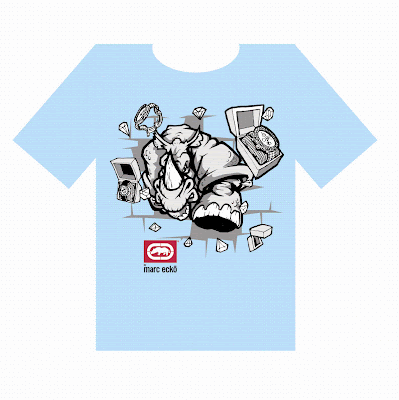
I have tried to express my own critique of society in a recent project. The image above shows a man with a balaclava and the word identity in front of him. The image is meant to represent the anonymity of the graffiti artist; the green letters are bold and clear to show the juxtaposition of the graffiti artists hidden identity and our democratic society; where we should have the right to freedom of speech and identity. Well informed and highly skilled artists must still keep their identity concealed as society is yet to open its arms to the resistant art form. However, we can clearly see that graffiti is slowly being integrated into society, through commercial commodities and the actions of artists to inform the public of graffiti’s creative potential.
This Commercialization has “made it difficult for anit-graffiti forces to argue that all graffiti is vandalistic in nature” (Gregory J. Snyder, 7). The mass media has recognised graffiti’s creative and capitalist potential as audiences are growing to accept the art form. This commercialisation “moves writers out of the boundaries of the subculture", because artists "no longer paint for their peers and themselves, they have a new audience"(Nancy Macdonald, 90 – 91) This process is termed, recuperation, whereby radical artwork rebels against contemporary social and political ideologies, yet it becomes socially acceptable through its commoditisation. Within graffiti this can range from t-shirt design, magazines, CD covers, spray paint, commissions, games, illustration or graphic design. I myself have made this recuperative move, in which I paint legal murals with a local community group. (I painted all 3 characters in the picture below)


The youth group negotiates with councils to allow graffiti murals in certain area, by creating murals we can show the artistic side to graffiti and help improve people’s attitudes towards graffiti. I have also begun producing and selling graffiti works on canvases’, wood etc. (below are three examples of my work)


I feel that with my improved skills and creativity I can create graffiti that is commercially viable and contrasting to the ‘tag’, in which most people stereotype graffiti.
A great example of graffiti’s acceptance into society has been Mark Echo. A former graffiti artist, he integrated his graffiti into graphic design and the mass culture through commissions, galleries and his own clothing company.

Teck 1 (2007). Mark echo t shirt design: available from: http://monorex.blogspot.com/2007/07/marc-ecko-tee-design-by-teck-1.html
He also moved onto creating a graffiti game, in which you run around ‘bombing’ the streets.

Mark Echo (2006). Getting up: available from:
http://en.wikipedia.org/wiki/File:Getting_Up.jpg
It just shows the dramatic transition of graffiti’s relevance and acceptance within society since the 70’s. Now the capitalist institutions are accepting the subculture and in doing so are helping it integrate into mass society. But will this lead to the end of a revolution and the saturation of meaning?
Looking back at what I’ve discussed in this essay we can clearly see a link between modern and postmodern movements of resistance. Modernisms’ avant-garde movements clearly show a revolt to society and traditional ideologies through techniques and context of art. This is also evident in our contemporary society, “in which the mass media and popular culture are the most powerful institutions”. The use of “popular cultural signs and media images increasingly dominate our sense of reality and the way we define ourselves and the world around us” (Strinati, 205). So in order to keep their identity and resist ‘the spectacle’ of current capitalist ideologies, subcultures like graffiti, Subvert and disrupt images, walls, and objects; showing criticism of the current portrayal of reality in a way that contemporary audiences can relate to and see. However with this social acceptance comes the introduction of the commodity, and commercialisation, which in turn begins to blur the social and confrontational boundaries.

No comments:
Post a Comment